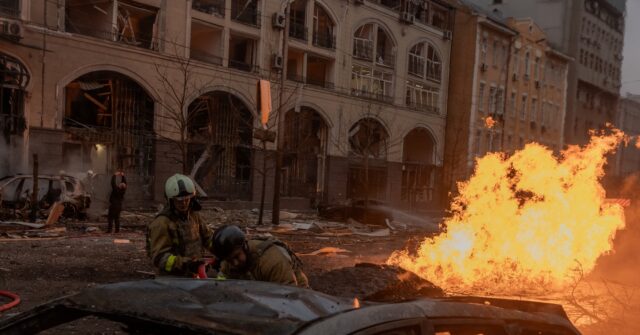In a recent and devastating escalation of hostilities between Russia and Ukraine, a Russian ballistic missile attack on Kyiv claimed the life of at least one individual and left nine others injured. This attack occurred early on a Friday morning, shortly before sunrise, resulting in significant damage to the city’s infrastructure. Kyiv’s air force reported that they intercepted five Iskander short-range ballistic missiles, although several still succeeded in striking the city. The fallout from this attack was severe, leading to a loss of heating in approximately 630 residential buildings, 16 medical facilities, and 30 educational institutions, including schools and kindergartens. Debris from the missiles also caused damage and sparked fires across three districts, underscoring the ongoing peril faced by civilians in Ukraine amid escalating military actions.
In defending its missile attack, Russia claimed it was a direct response to a prior Ukrainian strike on targets in the Rostov border region, which had occurred two days earlier. This earlier Ukrainian offensive was noted to have utilized American-made Army Tactical Missile System (ATACMS) missiles alongside Storm Shadow missiles provided by the United Kingdom, specifically targeting an oil refinery in Rostov. Such exchanges illustrate a troubling pattern in the conflict, where Ukraine seeks to undermine Russian military capacity and logistical support through targeted strikes, while Russia retaliates with aerial bombardments aimed at critical civilian infrastructure in Ukraine.
Over the course of the nearly three-year war, Russia has frequently bombarded civilian areas in Ukraine as a strategy to disrupt normal life and achieve psychological impact on the populace, primarily through efforts aimed at crippling the power grid and inducing fear. In parallel, Ukraine has had to navigate the dual challenges of defending against Russia’s larger military forces on the front lines while attempting to carry out counter-strikes on Russian facilities that represent key operational support for the war effort. This strategy reflects Ukraine’s adjustment to the realities of warfare where both offensive and defensive capabilities are continually evolving.
The Russian Ministry of Defense emphasized its belief that the attack on Kyiv was justified, citing a need to respond decisively to Ukrainian provocations. They claimed the destruction of key Ukrainian military assets, including command centers for military intelligence and locations involved in the production of Neptune missile systems. This assertion came alongside a declaration that the attack had successfully achieved its military objectives, although these claims remained unverifiable at the time. The two nations have remained locked in a tit-for-tat conflict, where military strikes are increasingly met with retaliation, fueling concerns over further escalations that could involve even more potent weapons systems.
In a noteworthy development, Ukraine’s recent utilization of Western-supplied weaponry to strike Russian territory—particularly following an easing of restrictions by the United States—has spurred intense reactions from Moscow. President Vladimir Putin hinted at the potential for introducing new hypersonic missile technology, suggesting that targets such as government buildings in Kyiv were now within reach. This marks a significant shift in the conflict, whereby weapons originally intended for defensive purposes are being employed in offensive operations, leading to a rapid escalation in tensions.
As the conflict progresses, both sides appear entrenched in their strategies, with Ukraine determined to diminish Russian military capabilities while Russia aims to disrupt Ukrainian civilian life and infrastructure. This cycle of violence highlights a deeply concerning trend in modern warfare, where civilian areas become battlegrounds, causing widespread humanitarian crises. The ongoing military actions—whether through missile strikes, aerial bombardments, or ground offensives—underscore the urgent need for diplomatic efforts to quell the violence and seek a resolution to the hostilities that continue to ravage Ukraine. With both countries indulging in increasingly aggressive tactics, the international community watches closely, fearing the potential for broader ramifications beyond the immediate theater of conflict.

